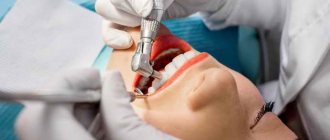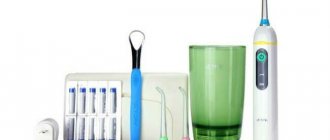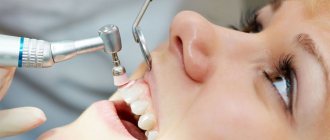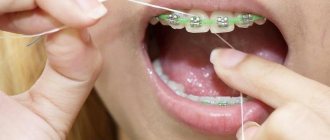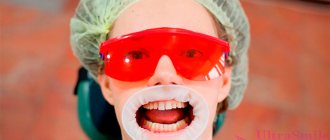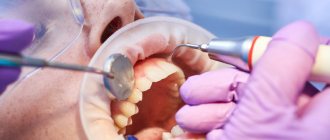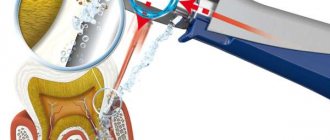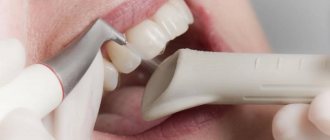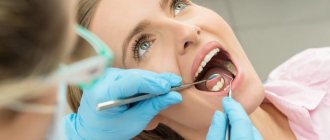Who is recommended for cleaning?
This procedure is recommended for any gum disease. It is usually prescribed when a patient is diagnosed with periodontal disease, periodontitis or gingivitis. Dental manipulation can also be performed if the following symptoms are present:
- Acute reaction to cold or hot.
- Bleeding gums.
- The appearance of “pockets” between the tooth and gum.
- Unpleasant odor from the mouth.
Indications
Cleaning periodontal pockets provides:
- complete removal of plaque and calculus from tooth enamel (including the surface of the crown in the subgingival part);
- protection against the appearance of cervical caries, carious lesions of the root part of the teeth;
- cessation of inflammatory processes that have already begun;
- slowing down the development of chronic periodontal diseases, prolonged relapse;
- elimination of foci of infection;
- strengthening of gum tissue, under favorable conditions - regeneration of bone tissue, strengthening of teeth.
Without regular professional hygiene, microorganisms accumulate on the surface of the enamel and on the subgingival part of the crown, forming plaque, which later turns into hard deposits (tartar). A layer of tartar separates the gum margin from the crown. The gum tissue is constantly injured, its nutrition is disrupted, and the ligaments supporting the tooth may gradually be destroyed, causing the teeth to become mobile and gradually loosen. The risk of such disorders is especially high for smokers, with poor oral hygiene, and with a predisposition to the occurrence of periodontal diseases. Professional hygiene with cleaning of periodontal pockets reduces it.
Execution algorithm
Before you begin cleaning, it is imperative to carry out some diagnostic procedures. Depending on the diagnosis and severity, different procedures may be required:
- Radiography.
- Sanitation of the oral cavity.
- Professional cleaning of units from stone and surface deposits.
The procedure is carried out in two stages, that is, the patient must visit the doctor twice. The algorithm for treating gums through cleaning is individual. Based on your cleaning goals, the steps may vary slightly.
- During the first session, hard formations located in the pockets between the gums and teeth are removed.
- Next, antiseptic treatment is carried out with special medications.
- The dentist applies a therapeutic bandage to the damaged areas of the gums.
- At the second visit, the dentist polishes the teeth and whitens the enamel several shades using an air-abrasive system.
- The final step is to apply fluoride varnish to the surface of the teeth.
After the procedure, a positive effect is observed. Using this procedure, it is possible to remove pathological bacteria, which are often the culprits in the development of oral diseases. After treatment, the likelihood of developing periodontal pathologies is significantly reduced, positive dynamics are clearly observed in existing diseases, and disturbing symptoms disappear.
Why is it worth supplementing professional hygiene with periodontal cleaning?
The condition of periodontal tissues affects the health of teeth. These tissues include the gums, periosteum, jaw bone, and supporting ligaments. The appearance of periodontal diseases is often provoked by insufficiently effective hygiene and associated inflammatory processes. Periodontal hygiene reduces the risk of developing periodontal diseases and stops them if they have already appeared.
Features of periodontal cleaning
Since with gingivitis, periodontal disease or periodontitis, the gums are hyperemic and painful, this manipulation can be performed with anesthesia. In this case, the patient will not experience pain or discomfort.
After cleaning, you must follow some rules to secure the result:
- From the moment the procedure is completed, you need to follow a dietary diet so as not to injure the gums and allow them to “heal” calmly. First of all, it is important to observe the temperature regime; food should be warm; cold and hot foods are prohibited during the week. You should also avoid salty, pickled, spicy, etc.
- The duration of the break between two sessions should not exceed seven days.
- Follow your doctor’s recommendations; depending on the diagnosis, the specialist may prescribe certain medications, rinsing the mouth with special solutions, etc.
- If necessary, a specialist may prescribe painkillers.
- Periodontal cleaning is not suitable for everyone; there is a list of contraindications. These include the period of bearing a child, breastfeeding, open foci of infection in the oral cavity.
Basics of periodontal teeth cleaning
Indications for periodontal teeth cleaning are various moderate and severe periodontal pathologies, such as periodontitis, periodontal disease, gingivitis, as well as structural features of the gingival and bone pockets of the patient’s oral cavity.
Before starting the hygienic procedure, an examination is carried out, a mandatory initial examination is carried out by drawing up a visual orthopantomogram and measuring the depth of the periodontal canals with special probes. In the process of periodontal teeth cleaning, sterile medical instruments, disposable masks, gloves, saliva ejectors and other personal devices are used, due to which the risk of infection of the patient during the procedure is completely eliminated. To eliminate pain, local injection anesthesia is used with modern drugs that provide reliable pain relief without any side effects.
Learn more about the benefits of teeth whitening and teeth cleaning
Comprehensive gum treatment in our Center
The procedure for curettage of periodontal pockets is part of the complex therapy of gum diseases. It is a basic technique - without cleaning the pockets it is impossible to achieve successful results, since it will not be possible to completely remove deep dental plaque using professional hygiene and rinsing the mouth with antiseptics. If the gum pockets are not cleaned out, the inflammatory process will progress, the periodontal tissues will be destroyed, and the teeth will gradually become loose and fall out.
But in advanced stages of the disease, curettage, as a separate procedure, also cannot always solve the problem. Therefore, an integrated approach is important for periodontitis, which includes the following measures:
- Professional hygiene Removal of dental plaque from the surface of teeth using ultrasound and Air-Flow sandblasting machine. Aimed at ensuring sterility of the oral cavity and preventing tissue infection during subsequent curettage.
- Splinting of teeth is mandatory for tooth mobility. In case of bone loss, teeth are held in place only by dental plaque. After cleaning, they remain without support and can fall out immediately during the procedure. To avoid this, thin fixing splints are placed on the inside of the teeth.
- Gum curettage Cleansing gum pockets from accumulated deposits. The technique is selected based on diagnostic results and depending on the stage of the disease.
- Surgical treatment: Gumplasty is performed in the presence of large periodontal pockets or, conversely, gum recession. In the first case, part of the mucosa is excised, and a new aesthetic contour is formed. In the second, the gum is grown by transplanting from the palate.
Additionally, anti-inflammatory and antibacterial drugs, periodontal dressings, and plasmolifting of the gums can be used.
We treat gums in a comprehensive manner! In our Center, only an integrated approach is used in the treatment of gum diseases. Relieving symptoms will not solve the problem. If the cause of inflammation is not identified and eliminated, over time the situation will only worsen, even to the point of tooth loss. Thanks to complex therapy, a combination of therapeutic, surgical and reconstructive techniques, it is possible not only to stop the pathological process, but also to restore up to 80% of destroyed periodontal tissue.
Oral hygiene methods
At Beskudnikovo Dentistry, the procedure takes place in the following sequence:
- Examination of the oral cavity. Using a staple and an oral mirror, the doctor assesses the condition of the dental system and mucous membrane. If there are pathological changes, he plans treatment and sets a date for a second consultation. The patient is informed in advance about all stages, timing, and cost of the procedures. A preventive dental examination should be carried out once a year if there are no complaints.
- Air-flow teeth cleaning. Neutralizes soft dental deposits, in particular food dyes and smoker's plaque. Using a special powder with water under pressure, the chewing, lingual and palatal surfaces of the teeth, the interdental space are cleaned, and periodontal pockets, if any, are washed out. The procedure is absolutely painless and does not cause any harm to the enamel or gums.
- Ultrasonic teeth cleaning. Using an ultrasonic scaler, supragingival and subgingival tartar is removed from the surface of the teeth, in fissures, and interdental spaces. The doctors at Beskudnikovo Dentistry carefully break down all dental deposits, since the remaining stones injure the gums, pressure exposes the neck of the tooth, and increases tooth sensitivity.
- Polishing the surface of teeth and fillings. Special rubber heads, brushes, strips and abrasive pastes smooth out the enamel structure, remove chips, unevenness, cracks and roughness. Perfectly smooth enamel prevents the accumulation of food debris and plaque, which poses a great threat to periodontitis (inflammation of the tissue around the tip of the tooth root).
- Enamel coating with fluorine varnish. The final stage of oral hygiene. It is not carried out for all patients, but in cases of hypersensitivity of teeth, a tendency to caries, and also to increase the service life of fillings. Fluoridation is especially recommended for children after changing teeth, during periods of active growth and in the presence of braces.
The doctor must not only remove plaque, but also, if necessary, teach the patient the rules and methods of oral care and the correct technique for brushing teeth.
Indications for teeth cleaning at the dentist
Experts recommend going to the dentist for hygienic cleaning for preventive purposes, but in some cases the procedure is a necessity.
Indications for professional dental cleaning:
- formation of dense soft or hard plaque;
- formation of tartar in the subgingival and supragingival locations;
- treatment of periodontal pathologies;
- the appearance of an unpleasant odor from the mouth;
- bleeding gums;
- enamel whitening (as the first stage of the procedure).
Teeth cleaning can be prescribed by a doctor if the patient does not notice signs of tartar, but regularly undergoes medical examinations at the dentist.
The Dentpremium dental center uses only gentle cleaning methods that do not have a toxic or traumatic effect on tissue. The absence of risks of negative effects on the body does not imply the presence of contraindications. Refusal from the procedure can only be obtained in the presence of severe inflammatory diseases until the patient’s condition has stabilized. Depending on the method of brushing your teeth, contraindications may differ.
Methods
Professional teeth cleaning in Moscow at the Dentpremium center differs from home hygiene in the use of innovative techniques and an integrated approach to the procedure. The dentist's office provides a service for manual and mechanical teeth cleaning to remove plaque on the gums and tartar. The procedure is performed by a dental hygienist or periodontist. The procedure has a primarily preventive purpose, so no preparation is required. The service can be provided on the day of the appointment.
Curettage
Curettage is considered an effective method of hygienic teeth cleaning in Moscow at the Dentpremium clinic. This method of professional teeth cleaning has not only a preventive, but also a therapeutic effect, and is often recommended for periodontitis.
As a result of the procedure, it is possible to eliminate not only tartar and plaque, but also granulation tissue in the gum pockets.
The use of curettage is allowed only in difficult cases, since the procedure consists of a surgical intervention that involves the removal of deep-seated complications with detachment of gum tissue and subsequent manual cleaning.
Air Flow
The most popular method of teeth cleaning with an affordable price is Air Flow. This technique is popular not only because of its reasonable cost, but also because of its effectiveness and safety.
The essence of the procedure is to expose deposits to a powerful directed flow of air and abrasive particles (sodium bicarbonate). Under a strong flow, solid particles of deposits are torn away from the surface of the tooth and washed away with a stream of water, which is supplied simultaneously to remove particles of tartar, prevent tissue injury, overheating of the treated surface and hygienic effects. Additionally, to eliminate the unpleasant odor from the products used, fragrances can be added to the water, creating a feeling of freshness in the oral cavity.
The use of Air Flow cleaning allows you to achieve an effect not only in removing deposits. As a result of the procedure, pigmentation is eliminated, partial whitening and polishing of the enamel occurs.
Reviews about this method of teeth cleaning confirm its advantages:
- safety;
- affordability;
- absolute painlessness;
- perfect result.
The duration of the procedure is 20–30 minutes.
Dentpremium clinic specialists provide an individual approach to patients, selecting the strength of the flow of microparticles and air depending on the available volume of tartar, enamel thickness, associated pathologies (if any) and tissue sensitivity.
Contraindications: obstructive bronchitis, allergies to abrasive substances used or products used, bronchial asthma, acute period of oral diseases, pathological thinning of enamel, severe caries, excessive sensitivity of enamel.
Ultrasound method
Ultrasound is also used in professional teeth cleaning. This is a safe, fast and effective method of removing deposits. A significant advantage of ultrasonic cleaning is the ability to remove even hard deposits even in hard-to-reach areas. The use of ultrasound allows for antibacterial treatment to be carried out simultaneously with cleaning.
The procedure is carried out using a special device, additionally equipped with several attachments for influencing different areas of the surface being treated. The process of rejection of hard deposits is accompanied by the destruction of stone, which prevents tissue trauma in the gum pockets. Removal of loose deposits is carried out using a stream of water and tools.
Contraindications: the presence of an electrical pacemaker, renal/pulmonary/liver failure, cardiovascular pathologies (severe), enamel demineralization (extensive), purulent processes in the oral cavity, inflammation of the mucous membrane, the presence of orthopedic dental structures.
Laser method
The most advanced method in dentistry is teeth cleaning using laser beams. The effectiveness of the laser on dental plaque is explained by the layer-by-layer destruction of tartar due to the evaporation of the liquid that it contains in large quantities.
The laser cleaning procedure does not involve contact of the surface being treated with tools. All manipulations are carried out at a distance, which eliminates pain, tissue injury and infection.
This method also gives a whitening effect, which allows you to save on additional services. The undoubted advantage of the laser is its antibacterial effect, acceleration of cell regeneration and prevention of caries.
Contraindications: ARVI, rhinitis, the presence of any implants in the body, severe infectious diseases, orthopedic dental structures, asthma, epilepsy.
Manual method
This method has been practiced for a long time. It has significant disadvantages, one of which is the increased risk of injury, so it is rarely used. The advantage of manual teeth cleaning is the cost.
The procedure involves removing stones from the surface of the tooth using instruments. Since this method of cleaning may leave deposits in the gum pockets and other hard-to-reach places, this method is used in modern dentistry only as the first stage for removing large deposits, which are impossible to remove using laser, ultrasound or other methods.
Disadvantages of manual brushing also include the risk of infection, weakened gums and tissue inflammation.
The use of modern means and devices makes it possible to reduce the risk of injury; however, they are used only after hardware cleaning until the result is perfect.
Advantages of manual cleaning: smoothing out enamel irregularities after stone removal, eliminating deposits in interdental spaces and other places inaccessible to laser or ultrasound, removing enamel pigmentation, preventing gum and dental diseases.
Modern manual cleaning involves the use of strips, which are small strips with a rough surface. Dental floss and floss are also used. It is popular to apply polishing paste with a special brush.
Recommendations
After having your teeth cleaned in the dentist's office, you should follow the recommendations for caring for your teeth for the first few days.
On the first day, you should not eat foods that contain dyes and large amounts of acids. It is not advisable to drink tea or coffee. It is worth giving up smoking.
After completing the procedure, the dentist himself applies prophylactic agents to the teeth that have a regenerating and strengthening effect on the enamel.
Benefits of oral hygiene in Moscow
Dentistry Beskudnikovo is a modern multidisciplinary clinic. Provides a wide range of services to maintain healthy teeth and gums and treat dental diseases. The center is equipped with modern equipment for oral care. Specialists with significant experience select an effective set of hygiene procedures, taking into account the condition of the dental system and contraindications.
At Beskudnikovo Dentistry, professional oral hygiene is carried out at affordable prices. The cost depends on the complexity and stages of work, the presence of anesthesia. The initial consultation and development of a treatment plan is free.
Indications and contraindications
Comprehensive professional oral hygiene is recommended to be carried out at least once every six months.
An unscheduled procedure is necessary in cases where the patient is undergoing various types of dental procedures:
- professional teeth whitening,
- treatment of caries and gum diseases,
- surgical intervention,
- implantation and prosthetics.
After professional cleaning, it is easier for the dentist to determine pathological processes in the dental system.
Oral hygiene is important during pregnancy. Against the background of hormonal changes, the viscosity of saliva increases, which contributes to the accelerated formation of dental plaque. The procedure is recommended to be carried out in adolescence and after a change in bite, since during these periods the degree of caries activity is the highest.
Contraindications depend on the complex of procedures. Thus, ultrasonic teeth cleaning is not carried out in childhood and adolescence, in the presence of milk teeth or recently erupted permanent teeth, due to the risk of injuring tooth enamel. In this case, dental plaque is removed using Air-flow.
Also, ultrasound is not used in the presence of arrhythmia, pacemakers, braces, or dental implants. Other contraindications are HIV, tuberculosis, diseases of the oral mucosa, bronchial asthma, hepatitis.

